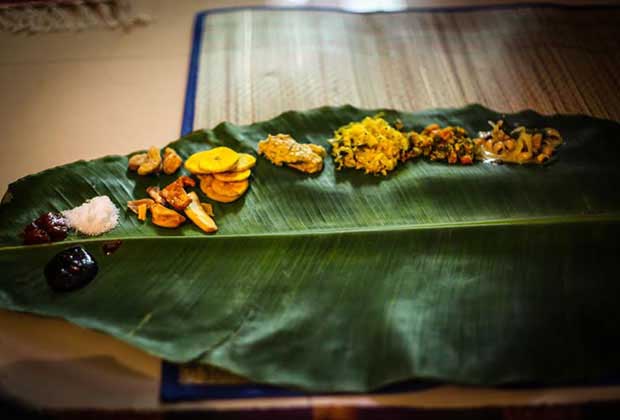Onam And The Happiness Called Sadya
- By Sumitra NairLoading...
- | 28 Aug 2015 6:17 AM GMT
 X
X
 An Onam sadya is a pure vegetarian meal. Photo: Poppaddum
An Onam sadya is a pure vegetarian meal. Photo: Poppaddum
The countdown to Onam is so contagious that you catch the fever even if you aren’t a Malayali. It is considered to be one of the most secular festivals as it celebrates the return of a kind and generous king, and not any deity per se. And though Mahabali, the legendary king is supposed to be a rakshasa (a community that lived an unruly life and was feared by devas), he is eagerly awaited by his subjects who adore him. This is the very reason why Hindus, Christians and Muslims come out to celebrate it with equal gusto.
For me, growing up in Bombay, celebrating Onam meant a chance to meet all my cousins. And since my maternal grandmother lived just a building away, we all would go to her place dressed in pattu pavadas (skirt and top made from silk) for the feast. We would eagerly wait to be served nearly 25 delicacies on the plantain leaf.
It would include steamed rice with parippu (dal), an assortment of side dishes like kalan, veggies cooked in a yoghurt-based curry; olan, a mild coconut-based curry made with pumpkin and a certain variety of beans; pachadi, a raita-like accompaniment, sambhar and kootu curry, which is prepared using yam and raw green plantain and black chana. There would be a variety of pickles too such as lime and ginger. All this would be accompanied by banana chips, and a serving of payasam and pappadam (kheer and papad) in the end.
The variety of curries and vegetables on one platter is supposed to symbolise prosperity during Mahabali’s reign, and the grand feasts he hosted to ensure that no one in his kingdom starved. It is also because Onam coincides with the harvest season. There is an old saying - “Kaanum vittu Onam unnanam”, or one must feast even if it means selling one’s home. This essentially means that the poorest man will have a feast, even if it means to sell everything he owns.
Then all the kids would play together. For me and my cousins who grew up in an urban jungle, we were only familiar with games like hide-and-seek or catch, rather than the traditional tug-of-war and onathallu (wrestling). During my teen years, we would join the adults in the preparation to make sadya by the helping them chop vegetables the previous night. This activity involving mostly my mother, her sisters and their daughters, would invariably turn into a session of catching up.
But, Onam celebrations have been scaled down in the last five to six years. My grandmother, whose energy levels have dwindled, does not feel like prepping for a feast for only a handful of guests. She therefore encourages us to order home the sadya. So, just as the countdown for Onam begins, we place our order with the most sought-after caterer. And on the D-day after making a floral rangoli and dressing in all finery, we wait for the food to arrive. This has now become a norm in many urban homes. Though it is a celebration of a time gone by where inflation was unheard of, everything has become expensive right from pulses and vegetables to flowers for the rangoli! Then why go through all that trouble of gathering the raw ingredients, right?
I am now settled in Aluva, a town in Kerala post my marriage. And here too, I don’t find much difference in Onam celebrations except for a few cultural programmes and temple processions. I had bought flowers for my pookalam (floral rangoli) two days ago and stored it in the fridge (in case there is a sudden price hike). And after we decorate our verandah in the morning, we will be eating out at a local eatery for sadya. As for the next generation, I hope they at least get to play their fill in the oonjhal (swing) during Onam, lest the public gardens decide to make a disappearance too!
On this happy day, I am sharing my grandmother’s favourite recipe that is Kalan. She made it for us almost every time we had excess yoghurt in the house. And because it stayed in the fridge for 2-3 days, she would prepare it before she travelled ensuring we had enough of it in the fridge.
Maveli naadu vaneedum kaalam… (When king Mahabali ruled our land, everyone lived as equals).
 Kalan forms an integral part of an Onam sadya. Photo: Poppaddum
Kalan forms an integral part of an Onam sadya. Photo: Poppaddum
Recipe for Kalan
Ingredients
1 raw banana, roughly chopped
100 gms yam, cubed
½ tsp turmeric powder
½ tsp pepper powder
3 green chillies
½ tsp mustard seeds
2 red chillies
½ tsp cumin seeds
1 cup grated coconut
1 cup thick yoghurt
A few fenugreek seeds
2 tsp coconut oil
A few curry leaves
Salt to taste
Method
1. Steam the yam and banana till they’re well done.
2. Grind the coconut, green chillies, cumin seeds and fenugreek seeds with 2 tsp of water into a coarse paste.
3. In a kadhai, heat the coconut oil, add curry leaves, mustard seeds, red chillies.
4. Remove it from heat. To this, add the cooked vegetables, the coconut and spice paste, turmeric, pepper and salt. Mix well and serve.
This dish complements a meal of sambhar and rice, parippu (dal) and rice or rice and rasam with a side of pappadam and pickle.




